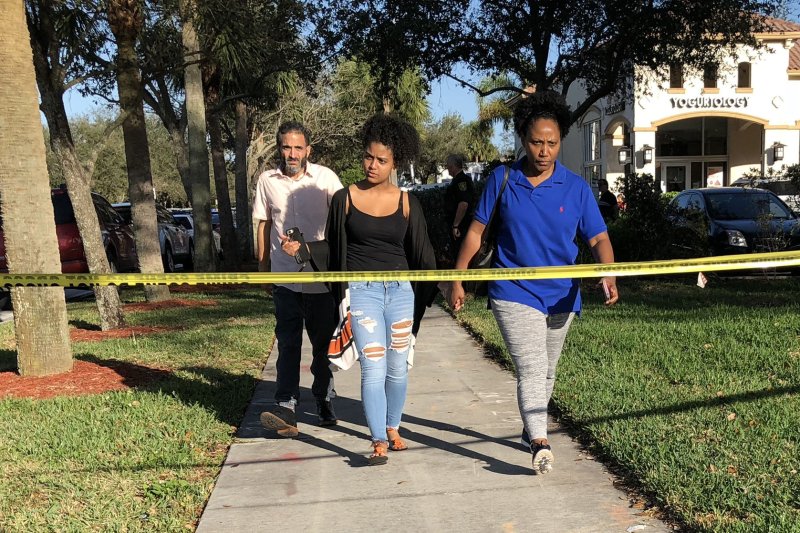"Biden has been a friend but not a leader,"

Students leave the area of Marjory Stoneman Douglas High School in Parkland, Fla., following a mass shooting there on February 14, 2018.
Feb. 14 (UPI) -- President Joe Biden and multiple advocacy groups on Monday recalled the deadly shooting attack at a school in Parkland, Fla., four years ago and pushed for new actions to prevent gun violence.
Seventeen people died at Marjory Stoneman Douglas High School in Parkland, near Fort Lauderdale, on Feb. 14, 2018, when former student Nikolas Cruz walked into the school with a gun and opened fire. A number of youth anti-violence groups were spawned from the attack -- some of which pressed Biden Monday for real efforts to keep guns out of the hands of people who shouldn't have them.
March For Our Lives, Guns Down America and Change the Ref launched an online tool Monday -- called "Shock Market" -- to track gun deaths nationwide since Biden took office in January 2021.
"Biden has been a friend but not a leader," David Hogg, founder of March For Our Lives and a survivor of the Parkland shooting, told CNN. "He's made small steps but it's not enough.

Flowers and 17 crosses are seen outside Marjory Stoneman Douglas High School, in Parkland, Fla., on February 26, 2018, to remember the victims of the shooting attack. File Photo by Gary Rothstein/UPI
In a message marking the anniversary of the Parkland shooting, Biden pressed Congress to do more.
"Out of the heartbreak of Parkland a new generation of Americans all across the country marched for our lives and towards a better, safer America for us all," he said.
RELATED Biden to visit NYC next week, meet with Mayor Eric Adams to talk about gun violence
"I've asked Congress to pass a budget that provides an additional half billion dollars for proven strategies we know reduce violent crime -- accountable community policing and community violence interventions. I have also requested increased funding for the Bureau of Alcohol, Tobacco, Firearms and Explosives and the U.S. Marshals.
"And Congress must do much more -- beginning with requiring background checks on all gun sales, banning assault weapons and high-capacity magazines, and eliminating immunity for gun manufacturers."

A young person holds a sign during a "March For Our Lives" rally in San Francisco, Calif., on March 24, 2018. The March For Our Lives movement was born out of the Parkland shooting.
RELATED San Jose becomes first U.S. city to require gun owners to carry liability insurance
Authorities say that Cruz legally bought the gun that he used in the attack, although he had brain development problems and depression.
Biden, however, is limited in what he can do as president, as it's mainly Congress' responsibility to regulate the buying and selling of firearms. Few Republicans have supported efforts to make it more difficult to obtain guns, and Democrats have only the slimmest of majorities in the Senate.
In December, Sen.Chuck Grassley, R-Iowa, blocked a request to proceed to legislation that the House passed a year ago to expand background checks.
By ZEKE MILLER and COLLEEN LONG
WASHINGTON (AP) — Four years after 17 people were gunned down at Stoneman Douglas High School in Parkland, Florida, families and gun control advocates are pressing President Joe Biden to do more to address gun violence.
One father of a victim killed in the shooting sent an early morning tweet Monday, the anniversary of the Parkland shooting, saying that he’d climbed a 150-foot-tall (46-meter-tall) crane near the White House.
“The whole world will listen to Joaquin today. He has a very important message,” the father, Manuel Oliver, said in a video tweeted at about 6:50 a.m., referring to his son, Joaquin Oliver. “I asked for a meeting with Joe Biden a month ago, never got that meeting.”
Oliver unfurled a sign that showed a photo of his son and criticized Biden for gun deaths on his watch. Police were called to the scene, where at least two people were on the crane. They said later that three people were taken into custody but didn’t identify them.
Meanwhile, dozens of advocates were set to rally outside the White House and unveil a website chronicling the 47,000 gun deaths and 42,000 gun injuries in the country since Biden was inaugurated. The tracker also lists the number of young people killed and injured as well as the number of mass shootings in the same time frame, and it includes a feature allowing users to publicly call on Biden and other administration officials to act against gun violence.
“As a candidate, Joe Biden promised to prioritize gun violence prevention. As president, Joe Biden has not,” said Igor Volsky, founder and executive director of the group Guns Down America.
In his first year in office, Biden’s efforts to pass legislation to tighten gun laws haven’t left the drawing board. He also was forced to pull his nominee to lead the Bureau of Alcohol, Tobacco, Firearms and Explosives. The group is calling on Biden to stand up a national office to address gun violence and to make a new nomination to head the ATF.
Biden said in a statement before the planned protest that the movement to end gun violence is “extraordinary.”
“We can never bring back those we’ve lost. But we can come together to fulfill the first responsibility of our government and our democracy: to keep each other safe,” he said. “For Parkland, for all those we’ve lost, and for all those left behind, it is time to uphold that solemn obligation.”
Since the Parkland shooting left 14 students and three staff members dead, gun violence at schools has only risen. There were at least 136 instances of gunfire on school grounds between Aug. 1 and Dec. 31, according to a tally last week by the gun control advocacy group Everytown for Gun Safety.
Biden has acted to crack down on “ ghost guns,” homemade firearms that lack serial numbers used to trace them and that are often purchased without a background check. He has worked to tighten regulations on pistol-stabilizing braces like the one used in a Boulder, Colorado, shooting that left 10 people dead. He’s also encouraged cities to use their COVID-19 relief dollars to help manage gun violence. But these efforts fall far short of major change.
There are limits to what the president can do when there is no appetite in Congress to pass gun legislation. The strongest effort in recent years failed, even after 20 children and six adults were killed in the 2012 Sandy Hook school shooting in Newtown, Connecticut. Parkland happened six years later.
Biden, a Democrat, said he’s asked members of Congress to provide funding to help reduce violent crime and said they must pass legislation requiring background checks on all gun sales, banning assault weapons and high-capacity magazines and eliminating immunity for gun manufacturers.
The U.S. Secret Service’s National Threat Assessment Center studied school attacks nationwide from 2006-18 and reported that most attackers were bullied and that warning signs were there. Most important, the researchers said, about 94% talked about their attacks and what they intended to do in some way, whether orally or electronically, and 75% were detected because they talked about their plots. About 36% were thwarted within two days of their intended attacks.

















